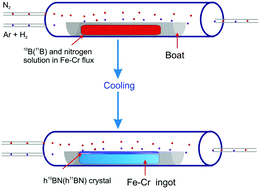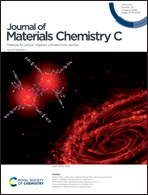Single crystal growth of monoisotopic hexagonal boron nitride from a Fe–Cr flux
Abstract
Hexagonal boron nitride (hBN) is an important insulator that is incorporated into numerous 2D electronic, optoelectronic, and photonic devices, whereas natural hBN is a mixture of 20% 10B and 80% 11B isotopes, and monoisotopic hBN is a variant with just a single boron isotope, either 10B or 11B. Consequently, monoisotopic hBN has a higher thermal conductivity and a stronger neutron absorption (in the case of h10BN), making it superior for neutron detectors, heat management materials in nano flexible electronic devices, and phonon polariton-based nanophotonics. Here we synthesized approximately monoisotopic hBN using boron powder containing a single boron isotope and nitrogen, and grew single crystals from a Fe–Cr metal flux at atmospheric pressure. Narrow Raman peaks from the shear (≤1.3 cm−1) and intralayer (≤3.3 cm−1) modes demonstrate that the crystals are highly ordered. In the photoluminescence spectra, the presence of phonon-assistant transition peaks is also indicative of the high-quality of the crystals. This growth protocol permits us to get rid of the emission at 4.1 eV. This work provides a novel material for studying the fundamental properties of isotopic effects and the high-performance hBN device.



 Please wait while we load your content...
Please wait while we load your content...
